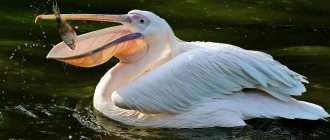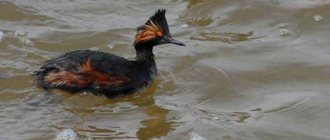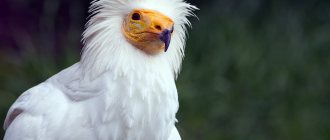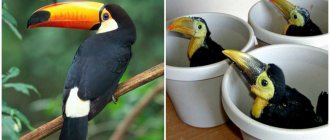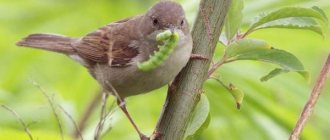| Latin name | Pelecanus crispus |
| English name | Dalmatian pelican |
| Squad | Pelicans or copepods |
| Family | Pelicans |
| Body length, cm | 170-190 |
| Wingspan, cm | 290-345 |
| Body weight, kg | 8-15 |
| Features | During the breeding season, the species has grey-white plumage, which contrasts with the yellow pouch-like lower part of the bill and the purplish-yellow bare skin around the eyes. On the back of the bird’s head there is a thick “silver comb” of feathers. |
| Number | About 10,000-14,000 individuals |
| Security status | Vulnerable (declining) |
| Habitats | In lakes, rivers. |
| Additionally | People call him the woman bird. |
- 2.1 Range
Description
Dalmatian Pelican (Pelecanus crispus) is the largest species of the Pelecanidae family. These birds are social birds, so they live and travel in flocks. On land, pelicans are not graceful, but they fly and swim well. During flight, birds rest their heads on their shoulders and their beaks rest on their folded necks. They flap their wings once or twice per second. These are diurnal birds that lead an active lifestyle during the day and sleep at night with their heads bent back, hidden in their feathers.
— Advertising —
The description of the Dalmatian Pelican states that the species spends most of its time resting, preening its feathers or preening itself.
Number
According to the International Union for Conservation of Nature and Natural Resources Red List, the Dalmatian Pelican has a total population size of approximately 10,000–13,900 individuals, corresponding to approximately 6,700–9,300 mature birds. Region-specific estimates are as follows: approximately 4,350–4,800 individuals live in the Mediterranean and Black Seas; about 6000-9000 in South Asia and Southeast Asia and 50 in East Asia. In general, Dalmatian pelicans are classified as vulnerable and their numbers are declining today.
Structure and dimensions
The bird's body length reaches about 170–190 cm, its weight is about 8–15 kg, and its wingspan is more than 3 m. The average weight of the bird is about eleven kilograms, which makes it the heaviest species of all flying birds in the world.
— Advertising —
The Dalmatian Pelican is similar to the Pink Pelican, but the former has more pronounced sexual dimorphism. Pink females are noticeably smaller than curly females, but males of both types are the same size and weight.
The Dalmatian pelican bird differs from the above-mentioned species in that it has long feathers on the back of its head, white plumage, and gray paws.
In winter, adult birds change the color of their feathers from silver-gray to a brownish-cream shade. The loose feathers around the adult bird's forehead create a W-shape of the face, sitting just above the beak.
During the breeding season, the species has an orange-red lower jaw and a distinct pouch, while the upper jaw is always yellow. In winter, the beak color is exclusively yellow.
The young are usually gray in color.
Harpy
Yes, you didn’t think so, this beauty is a representative of the hawk family. It is unique because it is the only one of its kind left. The length of the entire body ranges from 90 to 110 centimeters.
The weight of the harpy varies depending on the sex: females weigh up to nine kilograms and are much larger than males, whose weight is approximately 4-5 kilograms. The wingspan of these mythical harpies is about two meters.
Their entire body is adapted for hunting, for example, their paws are so strong that they can withstand even the largest prey; their black, huge claws help them in this. The beauty feeds on monkeys, sloths and other mammals.
Habitat
Many users are interested in where the Dalmatian pelican lives? The bird is found in lakes, rivers, deltas and estuaries. Compared to the roseate pelican, the species is not as tied to lowland areas and will nest in suitable wetlands with many elevations. It is less selective in its choice of breeding habitat, while the pink pelican returns to one mating site every year.
Area
There are two main populations of the Dalmatian pelican. One is common in Eastern Europe and winters in the eastern Mediterranean region. The other lives in Central Asia and Russia, and winters in the Indian subcontinent, Iran and Iraq.
Geography of the species:
Continents: Asia, Europe, Africa.
Subcontinents: South, West and East Asia, North Africa, Central Asia.
Countries: Albania, Armenia, Azerbaijan, Bulgaria, China, Egypt, Georgia, Greece, Hong Kong, India, Iran, Iraq, Israel, Kazakhstan, Kyrgyzstan, Lebanon, Moldova, Mongolia, Montenegro, Pakistan, Romania, Russia, Syria, Tajikistan, Turkey, Turkmenistan, Ukraine, Uzbekistan, Afghanistan.
Black Swan
And this bird is not only quite beautiful, but also very large. The height of a black swan reaches from 110 to 140 centimeters, and its weight is from four to eight kg. The main feature of this representative of the swan genus, in addition to its color, is its long neck, which allows it to hunt in the deepest bodies of water.
And if you look at this beauty in flight, you will notice that the neck forms a significantly larger part of the length of the body. Black swans are also real gentlemen, because these individuals have a voice with which they greet each other, while nodding their heads up and down.
Nutrition
The Dalmatian Pelican bird feeds almost exclusively on fish. Preferred prey species include common carp, common perch, red roach, eels, catfish, mullet, northern pike and so on. In the largest remaining colony, located in Greece, bleaks are reported to be the preferred prey. Bleak is a common species of fish from the carp family.
The Dalmatian pelican requires about 1.2 kg of fish per day.
It can also take local small species such as gobies, but usually ignores them in favor of larger ones.
The pelican obtains food independently or in groups of two or three. When fishing, the bird swims slowly and calmly, and then abruptly plunges its head under the water until it catches the fish along with a large amount of water. Next, the bird pours water from the sides of the bag and swallows the fish.
At times, the Dalmatian pelican does not eat all the prey from the pouch at once, leaving reserves for later.
Other small inhabitants of ponds and rivers can supplement the Dalmatian pelican's diet. These include worms, beetles, crustaceans, and small waterfowl.
Species and man
The pelican is a character in many fairy tales, legends, and myths. It is considered a sacred bird among Muslims - according to legend, it carried stones in its throat pouch for the construction of shrines in Mecca. In the Christian religion, the pelican has become a symbol of selfless parental love - as if it were tearing its own breast and feeding hungry chicks with blood. In fact, the chick “dives” so deeply into the parent’s throat for food that it almost hides in its beak, and people mistook the pinkish mush from the fish it obtained for the insides of an adult bird. An echo of this legend about the self-sacrifice of adults for the sake of children can be considered a symbolic prize for the best teacher of the year in Russia - a “crystal pelican” figurine.
Man sometimes uses the pelicans' ability to catch fish. Tamed birds go fishing with their owner, sitting on the sides of the boat. They carefully monitor what is happening underwater and, as soon as they notice a fish that has gaped, they slide into the water and grab it. And to prevent birds from swallowing large prey, they are given small collars. Pelicans swim up to the owner, open their beaks, give away large fish, and receive small ones in return.
Alas, most fishermen do not like pelicans. For them, these birds are competitors. However, if we want to live in peace and harmony with nature, we need to realize that we need to share both food and a place to live with “our smaller brothers.”
Reproduction
Most often this species nests in groups, less often alone. More often small colonies of over 250 pairs are formed. It is worth noting that other species of pelicans prefer to nest alone.
The bird's nesting sites are islands in large bodies of water, lagoons or river deltas, or dense thickets of aquatic vegetation. Due to their large size, these pelicans often trample vegetation in the area surrounding their nests, turning it into substrate. Thus, nesting sites can become unacceptably dirty after about three years.
Pelicans are serially monogamous, so they form pair bonds year by year rather than for life. As the new breeding season approaches, mating rituals begin. Mating occurs approximately a week after the pelicans return to their breeding grounds. Birds use a variety of social cues during courtship, both visual and vocal.
The nest is a moderately sized heap of grass, reeds, sticks and feathers, typically about 100 cm deep and up to 65 cm wide. Nests are usually located on or near the ground, often on dense floating vegetation. They are fragile until they are glued together with droppings.
Reproduction of the species begins in March or April. The Dalmatian pelican lays from one to six eggs, with an average of 2. The eggs weigh from 130 to 200 g. Incubation, in which both parents participate, lasts from 32 to 35 days.
When other birds get too close to their nests, pelicans defend them with hisses, squeals and beak strikes.
Chicks
The chicks are born naked, but soon acquire white downy feathers. Birds are able to fly at the age of 60-90 days, and hunt independently at about 12 weeks. The offspring becomes independent between 100 and 105 days of age. Nesting success depends on environmental conditions, with 60% to 100% of hatchlings successfully surviving to adulthood.
The chicks reach reproductive maturity at 30 months of age.
Migration
The bird usually migrates short distances. It is distributed in Europe, with most western individuals wintering in the Mediterranean region. The birds arrive in the Danube Delta in March and fly away by the end of August.
The species actively migrates to Asia. Most birds that breed in Russia winter in the central Middle East, mainly around Iran, to the Indian subcontinent, from Sri Lanka, Nepal to central India.
Pelicans, which breed in Mongolia, winter along the east coast of China, including the Hong Kong area.
Natural enemies
In different parts of the world where pelicans live, they are constantly hunted, due to a number of reasons. In East Asia, this is due to the fact that their fat layer is considered a medicine that is used in Chinese folk medicine. In India, this fat is also used as an effective remedy to combat rheumatic diseases. In southeastern Europe, pelican throat pouches serve as the basis for pouches, pouches, and sheaths.
Sometimes pelican hunting is not done in the most obvious way. Thus, colonies of brown pelicans located in South America were constantly attacked by people who collected feces there, used to fertilize the soil. To do this, workers had to destroy nests and destroy colonies. During such gatherings, newborn chicks often suffered.
In the wild, pelicans do not have many enemies, which is explained by their significant size. They are mainly hunted by terrestrial predators such as crocodiles and hyenas. Foxes can attack newborn chicks and destroy nests while they are not under the protection of their parents.
Dalmatian pelican in the Red Book
The Dalmatian pelican is listed in the International Red Book as a species with low numbers and at risk of extinction.
Dalmatian pelicans are threatened by wetland drainage, as well as shooting and persecution by fishermen who believe they are competing with them for fish.
Habitat degradation due to water pollution and changes in wetland composition are also currently a serious threat.
In addition, the beak of this species is traditionally used by the inhabitants of Mongolia to make tobacco pouches, which leads to a decline in the bird population.
Interesting Facts
- The bird's lifespan is 35-40 years.
- Dalmatian pelicans use the pouch not only to catch fish, but also as a cooling mechanism. They open their beaks in hot weather to promote evaporative cooling.
- Birds use fast wing movements and loud sounds to intimidate when a threat becomes visible.
- The expandable sac of skin that the pelican has at the base of its throat can hold up to 12 liters of water, which is several times more than in the stomach.
- Pelicans come from an ancient family of birds whose fossils date back nearly 40 million years.
- A seagull will often sit on a pelican's head in an attempt to steal food. This happens as follows: when the first one removes water from its beak, opening it slightly after catching prey, the seagull instantly grabs the food and flies away.
- It is not known for certain about the existing subspecies of the bird. But the subtype Pelecanus crispus palaeocrispus has been described from fossils recovered from Binagadi, Azerbaijan.
- The Dalmatian Pelican is often silent, as most pelicans tend to do. But during mating season it can be quite loud, making a wide range of different sounds.
- The age of a bird is determined by the degree of curl of its feathers: in older representatives the curl is more pronounced.
Cassowary
It's time for the first flightless bird in our top. If we translate the name of this bird, we literally get “horned head.” Most likely, the reason for this name comes from the growth on the head, which is simply called a helmet.
As for the growth of cassowaries, adult individuals reach up to one and a half, and in rare cases even two meters in height. Weight reaches about 60 kilos. It’s not for nothing that these animals are considered the largest birds in Australia.
What is unusual is that all cassowaries are very mysterious creatures. They feel good when located deep in the forests, so as not to be seen by the human eye.
It has also been noted that these representatives are most active at night. It is for this reason that not all types of cassowaries have been sufficiently studied. Many of them are simply hiding.
